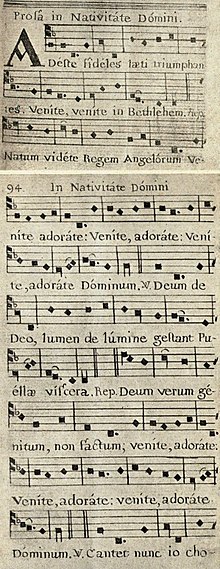O Come, All Ye Faithful

"O Come, All Ye Faithful" (in Latin: "Adeste Fideles") is a Christmas carol.
It is not known who wrote the music and words. Many people thought that it was written in the 15th or 16th century. However, this is not true.[1] It was first written down in the 18th century by John Francis Wade, an English Roman Catholic.[2] The music may have been taken from the a French opera called Le Comte d'Acajou. In the opera, there is an aria with a melody like the carol.[2][1][3]
At first, the carol only had four stanzas. Later, four more stanzas were added.[1]
Samuel Webbe published the carol in 1760. He translated the carol to English as "Draw Near, Ye Faithful Christians". Frederick Oakeley translated the carol as "O Come, All Ye Faithful" in 1841.[1]
Recorded Versions[change | change source]
The carol has been recorded in modern times by Classical and Pop singers like Ethel Smith, Luciano Pavarotti,[4] Frank Sinatra,[5] Andrea Bocelli, Laura Pausini, Enya, Janalynn Castelino,[6] Fairuz and Pentatonix.
References[change | change source]
- ↑ 1.0 1.1 1.2 1.3 Flood, W. H. Grattan (1915). "Notes on the History of 'Adeste Fideles'". The Musical Times. 56 (868): 360–362. doi:10.2307/910750. JSTOR 910750.
- ↑ 2.0 2.1 Zon, Bennett (1996). "The Origin of "Adeste fideles"". Early Music. 24 (2): 279–288. doi:10.1093/earlyj/XXIV.2.279. ISSN 0306-1078.
- ↑ Stephan, John (1947). Adeste Fideles A Study On Its Origin And Development. South Devon: Buckfast Abbey.
- ↑ "Pavarotti sings 'O Come All Ye Faithful' in Notre-Dame Cathedral in spine-tingling 1978 video". Classic FM. Retrieved 2024-01-07.
- ↑ Kelly, Ron (2023-12-25). "Frank Sinatra Christmas Music: 11 Tracks to Swing You Merrily into the Season!". Woman's World. Retrieved 2024-01-07.
- ↑ Rabinowitz, Chloe. "Janalynn Castelino Releases Rendition Of 'O Come All Ye Faithful'". BroadwayWorld.com. Retrieved 2024-01-07.
